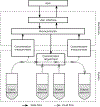An automated modular open-technology device to measure and adjust concentration of aquatic sperm samples for cryopreservation
- PMID: 36455857
- PMCID: PMC9969519
- DOI: 10.1016/j.slast.2022.11.002
An automated modular open-technology device to measure and adjust concentration of aquatic sperm samples for cryopreservation
Abstract
Repositories for aquatic germplasm are essential for safeguarding valuable genetic diversity for species relevant to aquaculture, biomedical research, and conservation. Development of aquatic germplasm repositories is impeded by a lack of standardization within laboratories and across the research community. Protocols for cryopreservation are often developed ad hoc and without close attention to variables, such as cell concentration, that strongly affect the success and reproducibility of cryopreservation. The wide dissemination and use of specialized tools and devices as open hardware can improve processing reliability and save costs. The goal of the present work was to develop and prototype a modular and open-technology approach to help to standardize the cell concentration of germplasm samples prior to cryopreservation. The specific objectives were to: 1) design and fabricate prototypes of the automated concentration measurement and adjustment system (CMAS), incorporating custom peristaltic pumps and optical evaluation modules, and 2) evaluate the performance of the CMAS with biological samples. Linear regression models were obtained for estimation of aquatic sperm concentration >108 cells/mL and for algae concentration > (3 × 105) cells/mL. Algae were diluted with extender medium by an automated process, resulting in a dilution precision of ±12.6% and ±6.7% in two trials, attaining means of 89% and 71% of the target cell concentration. The development of the CMAS as open technology can provide opportunities for community-level standardization in cryopreservation of aquatic germplasm and can invite new users, makers, and developers into the open-technology community. This will increase the reach and capabilities of much-needed aquatic germplasm repositories.
Keywords: 3-D Printing; Aquatic; Concentration; Cryopreservation; Dilution; Open technology.
Copyright © 2022 The Author(s). Published by Elsevier Inc. All rights reserved.
Conflict of interest statement
Competing Interests The authors have no competing interests to declare.
Figures






Similar articles
-
Exploring pathways toward open-hardware ecosystems to safeguard genetic resources for biomedical research communities using aquatic model species.J Exp Zool B Mol Dev Evol. 2024 May;342(3):278-290. doi: 10.1002/jez.b.23234. Epub 2024 Jan 7. J Exp Zool B Mol Dev Evol. 2024. PMID: 38185943 Free PMC article. Review.
-
Workshop report: Cryopreservation of aquatic biomedical models.Cryobiology. 2019 Feb;86:120-129. doi: 10.1016/j.cryobiol.2018.10.264. Epub 2018 Oct 31. Cryobiology. 2019. PMID: 30389588 Free PMC article.
-
The emerging role of open technologies for community-based improvement of cryopreservation and quality management for repository development in aquatic species.Anim Reprod Sci. 2022 Nov;246:106871. doi: 10.1016/j.anireprosci.2021.106871. Epub 2021 Oct 16. Anim Reprod Sci. 2022. PMID: 34750024 Free PMC article. Review.
-
Development of germplasm repositories to assist conservation of endangered fishes: Examples from small-bodied livebearing fishes.Theriogenology. 2019 Sep 1;135:138-151. doi: 10.1016/j.theriogenology.2019.05.020. Epub 2019 May 28. Theriogenology. 2019. PMID: 31220687 Free PMC article.
-
Design, alpha testing, and beta testing of a 3-D printed open-hardware portable cryopreservation device for aquatic species.J Appl Aquac. 2023;35(1):213-236. doi: 10.1080/10454438.2021.1955805. Epub 2021 Aug 4. J Appl Aquac. 2023. PMID: 36777239 Free PMC article.
Cited by
-
Exploring pathways toward open-hardware ecosystems to safeguard genetic resources for biomedical research communities using aquatic model species.J Exp Zool B Mol Dev Evol. 2024 May;342(3):278-290. doi: 10.1002/jez.b.23234. Epub 2024 Jan 7. J Exp Zool B Mol Dev Evol. 2024. PMID: 38185943 Free PMC article. Review.
-
Overcoming ice: cutting-edge materials and advanced strategies for effective cryopreservation of biosample.J Nanobiotechnology. 2025 Mar 7;23(1):187. doi: 10.1186/s12951-025-03265-6. J Nanobiotechnology. 2025. PMID: 40050919 Free PMC article. Review.
References
-
- World Health Organization WHO laboratory manual for the examination and processing of human semen. 6th ed. Geneva: World Health Organization; 2021.
-
- Certified Semen Services. CSS minimum requirements for disease control of semen produced for artificial insemination 2021.
-
- Dong Q, Huang C, Eudeline B, Tiersch TR. Cryoprotectant optimization for sperm of diploid Pacific oysters by use of commercial dairy sperm freezing facilities. Aquaculture 2007;271:537–45. doi:10.1016/j.aquaculture.2007.07.005. - DOI
Publication types
MeSH terms
Grants and funding
LinkOut - more resources
Full Text Sources

